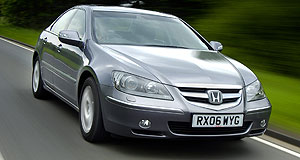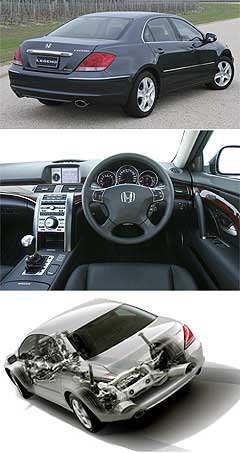First drive: Honda's Legend of the four
BY BYRON MATHIOUDAKIS | 16th Aug 2006

Priced from $74,500 – which is almost $12,000 lower than the unloved previous model, which was discontinued almost two years ago – the fourth-generation Legend will also become the most powerful Honda ever sold in Australia when it goes on sale from September 18.
Driving all four wheels is a revised version of the 3.5-litre single-overhead cam 24-valve V6 found in the MDX 4WD wagon, delivering 217kW of power at 6200rpm and 351Nm of torque at 5000rpm, as well as an ADR 81/01 average fuel consumption figure of 11.8L/100km.
This lightweight 60-degree V6 features Honda’s VTEC variable-valve timing, with a 4950rpm changeover point for the 12 two-mode intake valve intake points.
It meets Euro IV emissions compatibility, partly due to a new variable flow exhaust system fitted with a three-way catalytic converter. A drive-by-wire throttle system is also employed.
The only gearbox on offer is a five-speed automatic with a Tiptronic-style sequential shift mechanism located adjacent to the gear lever’s ‘D’ slot, or via paddles on the steering wheel.
Interestingly, Honda claims this transmission features the widest ratio spread of any five-speed automatic gearbox in its class, as well as a computer map to determine throttle position, vehicle speed and acceleration/deceleration factors.

SH-AWD also actively counteracts understeer and oversteer properties, aided by the standard stability control, traction control and ABS (with electronic brake-force distribution and brake assist).
Honda says it wanted this Legend to compete with Europe’s best, so it devised an independent double-wishbone front and Accord Euro-based independent multi-link rear suspension system, but with detail alterations.
Optimised with the SH-AWD set-up, it uses aluminium components to reduce unsprung weight and increase responses, traction and handling over a wide number of likely road surfaces.
The rack-and-pinion steering is electronically controlled and speed-sensitive, while the 320mm ventilated front rotors with four-piston callipers, and 310mm ventilated rear discs with large single-piston callipers, form a four-wheel disc brake system designed to surpass rival vehicles from BMW, Mercedes-Benz and Audi.
The latest Legend is also more efficiently packaged than its long-running predecessor.
Available only as a four-door sedan, the pronounced wedge-shape and underbody aerofoils make for better aerodynamics than before (0.29 is the drag co-efficient), while the body is 40mm shorter, 20mm higher and 25mm wider than the old Legend – which, at 1687kg, was lighter than the 1855kg newcomer.
To help contain weight, the larger body members are made of high-tensile steel, while aluminium is utilised in the bumper beams, subframes, bonnet, boot and suspension arms.
Correspondingly, body stiffness rises by one-third. Honda expects a five-star NCAP crash-test rating (not yet performed), while the body structure was devised with SUV or light truck side-impact protection in mind.
Other Legend body improvements include a new "ultra high gloss" paint method, doors that open a wider 80 degrees, 5mm-thick power window glass, and a bootlid with hidden hinges.
The Honda's pedestrian-impact bonnet system provides a crucial buffer zone from the hard engine components that invariably contribute to head trauma in the event of a collision.
Other interesting features include a novel "active noise cancellation" system that reduces low frequency exhaust noises from entering the cabin by using a counteracting audio signal through the door speakers and subwoofer located on the rear parcel shelf.
Honda has also worked hard to heighten the Legend’s showroom appeal.
Included in the package are dual-front, side and curtain airbag protection, leather upholstery, bona fide wood veneer, electric front seats (with heating and memory functions), high-intensity discharge headlights, cornering headlights, rain-sensing windscreen wipers, a sunroof, side and electric-rear sunblinds, a reversing camera, dual-zone climate control air-conditioning, ambient cabin lighting and two programmable keys that automatically set the seats, mirrors and wheel (among other things) to individual preferences.
A GPS satellite-navigation system has been fitted, but the Alpine software that is easily retrofittable will not be available for up to 12 months. It also works with the climate control system to ascertain the position of the sun and then cool/warm the cabin accordingly.
Wheels are 17x8-inch alloys shod with 235/50 R17 100W-rated tyres, while the spare is a stylised alloy space-saver.
Honda envisages selling 200 units between the car’s release next month and the end of the year, with around 6000 being the target for 2007.
Most rivals are either smaller or significantly more expensive when matched for specification. They include the BMW 3 and (lower-end) 5 Series, Lexus IS250 and GS300, Mercedes-Benz C and E-class and Audi A4 and A6.
The new Legend is only the fourth iteration of a series first released in Australia in May 1986. The original was a co-development with the Austin Rover Group, which sired the SD1-usurping Rover 800/Sterling series. Its more radical Mk2 replacement followed from April 1991.
Both generations benefited from a sales point of view by having a rakish two-door coupe as part of the line-up.
The last Legend was released locally in May 1996 with only a minor facelift in early 1999. Powered by 147kW 3.5-litre V6 engine married to a four-speed automatic transmission, it retailed for $86,550, and disappeared quietly in early 2005.
"We were over-optimistic (with the old pricing)," Mr Smalley said. "(Now) we want to demonstrate clear value for money, from $15,990 on Jazz up to $74,500 for (the Legend)." The 'super' handler
Honda claims its new "Super Handling" all-wheel drive system, based on the set-up first utilised in the current MDX in the early 2000s, has a number of world-first applications.
In gentle driving situations around 70 per cent of torque is transmitted to the front wheels, full throttle acceleration drops this to 60 per cent, while hard cornering sends up to 70 per cent rearwards, with all of this available to the outside rear wheel if necessary to correct an understeer situation.
Unique among other AWD vehicles, SH-AWD also increases the rotation speed of this outside rear wheel during hard cornering for more effective turning power, reduced understeer, better handling balance and greater cornering grip.
Honda claims the upshot of this is class leading cornering precision and traction, since the slower-turning front wheels enable the SH-AWD system to use the engine power to yaw the vehicle while turning, counterbalancing and controlling the normally ensuing understeer.
Aided by the standard stability control system, this is, in effect, a kind of rear-wheel steering correction function, and a new take on the term "torque steer"! The SH-AWD’s physical properties consist mainly of a torque transfer unit bolted to the front-mounted transaxle. Providing it with input torque is a helical gear attached to the front wheel differential’s ring gear, which turn a propeller shaft 90 degrees and move it to the vehicle’s centre line, with a composite propeller shaft then carrying power to the rear-drive unit.
This contains three planetary gear and clutch sets, with the first driving an electromagnetic clutch for each rear wheel.
It can alter between 30 and 70 per cent of the engine’s total torque output depending on conditions, as well as increase the output shaft speed by up to five per cent faster than the input shaft via a compact planetary gear set.
Meanwhile, a limited-slip differential function is provided by the other two planetary gear and clutch sets. They control the amount of torque that reaches each rear wheel, from zero to 100 per cent, thus creating the yaw moment under deceleration to stabilise the car.
Sensors connected to an electronic control unit oversees that everything works as planned, and even compensates for the eventual wear and tear on the system.